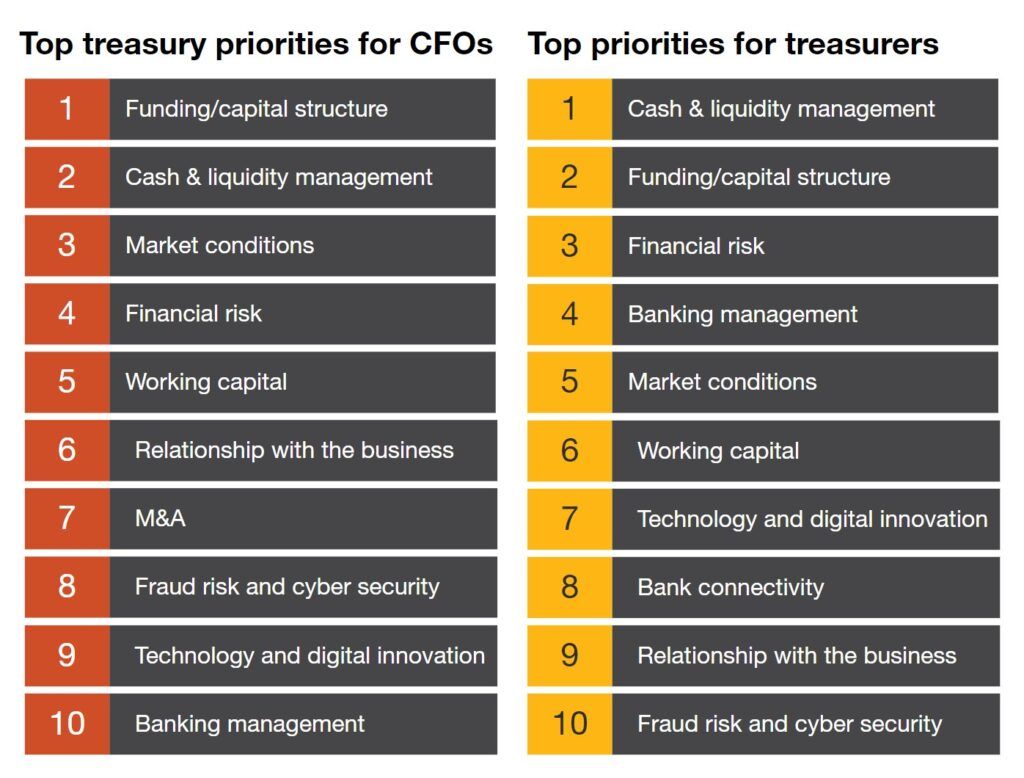Blog
Avoid Financial Woes with Cash Management Best Practices

Cash management is fundamental to the treasurer’s role, but all too often, inefficiencies and inadequate visibility prevent treasurers from putting their company’s cash to the best use. As an example, a recent PwC Global Treasury Survey still identified cash and liquidity management as the top priority for treasurers. Yet, maximizing returns without increasing risk is a growing challenge.

The principles of good cash flow management are well established, but as new solutions and technologies are developed, new opportunities present themselves. The treasurer of any company, no matter how large or small, should regularly take the time to review current cash management processes and ask whether best practice is being followed in each of the key areas.
When reviewing their cash management systems, treasurers should look into the following areas to seek improvements: cash visibility, cash flow forecasting accuracy, bank account management, bank connectivity robustness and last but not the least, payables finance opportunities.
Build Cash Visibility for a Solid Foundation
Visibility is a fundamental requirement for effective cash flow management, but treasury executives cite visibility as the top challenge they face in a 2022 Deloitte Global Treasury Survey. Without timely visibility over the company’s cash, treasurers cannot make effective cash management decisions and risk either holding too much or too little cash. Too little cash creates cash flow gaps and leads to financial instability, and while liquidity planning is important, maintaining too much cash in your liquid assets is inefficient and a waste of company resources. With good visibility, treasurers can embark on a series of decisions to manage cash and liquidity more efficiently.
While accurate and real-time information is key to visibility, many organizations lack confidence in their cash forecasts. For example, a recent study of finance and accounting professionals revealed that “two thirds agree that understanding cash flow in real time will be crucial – but just 2% of those surveyed by BlackLine are completely confident in the visibility they currently have”. Lacking clear visibility, treasurers may struggle to connect the dots among liquidity, working capital and investments. As a consequence, they will find it difficult to weather economic shifts.
With the value of cross-border payments projected to increase to over $250 trillion by 2027, treasurers overseeing global operations need an even deeper level of visibility when moving money internationally. International cash flow management is inherently complex, involving a large number of intermediaries, jurisdictions, time zones and regulatory framework. Without accurate visibility, treasurers cannot gauge the cash surpluses and deficits for each country and region or make appropriate decisions about the optimum use of cash on a country-by-country basis.
While it is easy to identify when the company has $500 million of excess cash in Asia, for example, that cash may be heavily weighted in a few different countries – meaning treasurers must consider tax implications and cross-border transaction costs. Whether repatriating funds to Once treasurers have clear visibility over existing cash balances, they will be in a better position to predict future cash positions. Cited as the top skill treasurers use to support their organizations in a recent AFP survey, cash flow forecasting is one of the most important activities carried out within treasury, but in many cases forecasting is not managed as accurately as it could or should be. As a result, the level of confidence that a treasurer has in the forecast may be limited.
When it comes to a cash management system, inefficiency costs more, while best practices and optimization drive more value to the bottom line.
Increase Accuracy in Your Cash Flow Forecasting
Once treasurers have clear visibility over existing cash balances, they will be in a better position to predict future cash positions. Cited as the top skill treasurers use to support their organizations in a recent AFP survey, cash flow forecasting is one of the most important activities carried out within treasury, but in many cases forecasting is not managed as accurately as it could or should be. As a result, the level of confidence that a treasurer has in the forecast may be limited.
Without confidence in the cash flow forecast, treasurers might leave idle cash sitting in the bank that could be invested more effectively if the company had access to more accurate information. The purpose of forecasting is to be as lean as possible and to use everything at the company’s disposal in order to maximize shareholder value.
To optimize the accuracy of the forecast, companies should focus their attention on three main components of the process:
- Collaboration – the right people need to be involved in the process. In many cases, however, the people with the necessary knowledge do not report to treasury, so cooperation across teams is critical.
- Consolidation – the right data sources must be included in the forecast. However, sources vary by profile of company and invariably some integration is required, which again depends greatly on cooperation with other teams.
- Measurement – the final component is to assess the accuracy of the forecast. To make the forecasting process meaningful, the project owner should measure how accurate the forecast is against actual results and then feed the results back to the appropriate sources and individuals, so that inputs can be refined going forward.
Once the accuracy of the cash forecast is improved, the next step is to create business value from the forecast. Treasurers can act on the forecast in different ways depending on the nature of the company. For cash rich companies, an accurate forecast can enable the treasurer to invest cash more strategically. Leveraged companies can pay down debt if they can apply excess balances to their borrowings. In other cases, companies may choose to use the surplus funds to earn higher returns through supply chain discounts, which treasurers can use to mitigate supply, demand and operational risk.
Treasurers gain many benefits from improved forecast accuracy, including the ability to adapt to market changes, make shrewd investments, alleviate debt burdens and improve confidence in their cash management system.
Build Value with Bank Account Management
A well-structured bank account management (BAM) strategy is another way treasurers can improve cash flow management. Treasurers need visibility and control over the company’s bank accounts, even if the responsibilities are decentralized to local resources.
Having proper processes and controls in place around bank account management provides a clear view over which bank accounts are being opened and who is opening them. To accurately monitor cash, companies need an accurate database of the company’s accounts and complete transparency over the signatories for those accounts.
Also important is the BAM system should have a workflow enforcing the segregation of controls, where one person opens an account and another person has to approve it. Without a controlled workflow, there will be limited value when eBAM is available on a public basis. The process must be based on a single system of record and an established set of controls.
Good bank account management practices do not stop there, however. Visibility into bank accounts must include an analysis of bank fees. The objective of this analysis is two-fold:
- Identify inaccuracies, so mistaken fees can be corrected
- Optimize banking services and accounts
Treasurers can drive the optimization effort by carefully analyzing the fees and usage of each service and account. Underused accounts (or empty accounts) cost organizations scarce budget dollars that can be redeployed elsewhere. This type of proactive financial management is the key to building value from treasury, rather than just improving productivity of current operations.
One development that can help treasurers improve cash management is electronic bank account management (eBAM). In its full form, complete with XML messages, eBAM is not yet a reality for most companies – but the industry-wide drive towards eBAM has led to higher awareness among companies of the importance of effective bank account management (BAM).
Bank account management is closely tied to treasury operations, with a well-structured bank management strategy enhancing efficiency and improving cash management.
Stay Ahead with Robust Bank Connectivity
Since real-time data integration is vital to effective cash visibility, automating connectivity to an organization’s banks is obviously an important cash management practice. There are many connectivity options to maximize cash management efficiency, including:
- Bank APIs
- Direct bank (FTP) connections
- Extensive coverage of networks (ACH, Fedwire, EBICS, BACs, EDITRAN)
- SWIFT Connectivity (SWIFT gpi compliant, SWIFT Service Bureau, SWIFT Alliance Lite2)
- Regional and Country Protocols
Experts should evaluate every bank connection based on the cost/benefit of acquiring the data. One popular choice for connecting to the company’s banks is via SWIFT. However, even when connecting via SWIFT is possible, it is not always the best choice. The profile of the organization’s bank relationships and the corresponding activity (types and volumes) will determine the best options – which is often a combination of SWIFT, host-to-host connections and regional protocols (e.g., EBICS). Connecting via SWIFT is usually easy, but it can be an expensive option.
The best practice for automating connectivity is to understand your connectivity needs (including volumes per transaction type) and to then make choices based on cost, ease of use and reliability of the connectivity option.
Maximize Cash and Liquidity with Payables Finance
While payables finance solutions might be new territory for treasurers, it’s worthwhile to investigate these options. These solutions allow businesses to improve cash flow management by unlocking the funds tied up in unpaid invoices, providing them with access to much-needed liquidity.
Payables finance is a short-term borrowing option for suppliers that uses the buyer’s creditworthiness. It enables buyers to enhance their working capital and allows suppliers to boost their cash flow by borrowing against unpaid invoices. Additionally, it offers an opportunity to strengthen supplier relationships by facilitating early invoice payments.
Payables finance solutions generate cash flow by extending payment terms, and they can also improve EBITDA by using excess cash to pay suppliers earlier for a discount. Typically, the following types of payables finance programs are available:
- Supply chain finance: This is a system of financial tools used to manage the liquidity of an organization’s supply chain. By providing access to funds, organizations can improve the flow of goods and services and optimize working capital.
- Dynamic discounting: This allows buyers to use excess cash and liquidity to fund early payments. Suppliers benefit from these discounts as they can improve their cash flow, reduce their cost of capital, and gain early visibility into their cash positions. For buyers, the benefit is improved EBITDA.
- Hybrid dynamic discounting: This cash management solution allows treasury teams to switch between supply chain finance and dynamic discounting, depending on cash availability.
Whether the goal is improved cash returns or optimized working capital, integrating treasury into the procure-to-pay cycle offers significant bottom-line value.
Effective Cash Management Boosts Business Value
While the foundations of effective cash management are firmly established, modern treasurers must build on those foundations to optimize returns on cash, improve working capital and make better financial decisions due to fast-changing business environments and increased volatility.
Fortunately, there are a number of tools and techniques available to improve cash and liquidity management, such as clear cash visibility, accurate cash forecasting, controlled bank account management, automated connectivity and payables finance. With a goal of continuous improvement, treasurers should routinely evaluate their cash management processes and align them with the best practices across these key areas.
As treasurers work towards optimizing their cash management strategies, they must also recognize effective cash flow management as an interconnected process – nothing can be done effectively without first having good visibility over the company’s cash. The benefits of clear visibility ripple across an organization’s cash management system, enabling adaptability, prudent investments and optimized supply chain dynamics. Cash visibility means better cash flow forecasting, which leads to better decision making – including investing cash, repaying debt and optimizing cash returns. Armed with the visibility into accurate cash forecasts, the CFO and treasurer’s best practices will create new business value for the organization.












